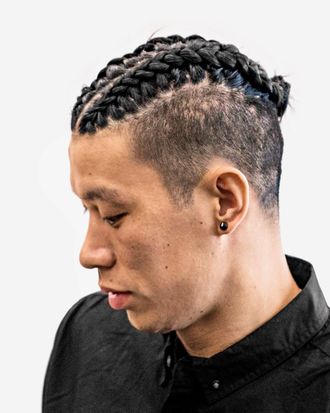
After a Brooklyn Nets practice in October, Brook Lopez, the team’s starting center, walks over to Jeremy Lin, the onetime Knicks sensation now returning to New York as a Net, to discuss a source of locker-room tension. Marvel has recently announced plans to feature Lin in an upcoming comic book, despite the fact that Lin — unlike Lopez, who is both an All-Star and a comics junkie — has only a passing interest in the medium. “He didn’t even tell me,” Lopez says. “I had to see it on one of my comics sites.”
Such are the privileges of being Jeremy Lin, the 98th-best scorer in the NBA last season. Lin’s month of remarkable basketball four years ago, combined with the fact that he is the most successful Asian-American player in history, created a phenomenon — Lin holds a trademark on the term Linsanity — that offers perks not given to most mid-level point guards. The least Lin can do, Lopez suggests, is get him a cameo.
“I’ll work on it,” Lin says.
“Maybe in the sequel,” Lopez says. “I’ll be the bad guy.”
Lin and Lopez are at the Nets’ new practice court in Industry City, which has a sprawling eighth-floor view that takes in the rising towers around Barclays Center and reaches almost to the Empire State Building, just down the street from the Garden, where Lin first became a superhero. If you’re hazy on Linsanity’s details — it happened way back when the Nets still played in New Jersey — here’s a refresher. Lin, the son of Taiwanese immigrants and a star at Harvard, went unselected in the 2010 NBA draft. The Golden State Warriors eventually gave him a contract, but Lin averaged two and a half points per game with them and got cut. The Knicks signed him as a fourth-stringer and played him sparingly until February, when they were 8-15 and figured they might as well give him a shot.
Over the next nine games, Lin averaged 25 points, led the Knicks to an 8-1 record, hit a game-winning three-pointer, and became one of a handful of basketball players (Kareem, Jordan, Bill Walton) to appear on back-to-back Sports Illustrated covers. Bars started serving Lintinis, and Rick Ross posted a photo of a new marijuana strain, Lin Sanity OG. Lin had to deny a rumor that he was dating Kim Kardashian. “I had no idea what was going on,” Lin says now. That summer, he signed a huge contract with Houston, whereupon his hot streak cooled. He was traded to L.A., then went to the Charlotte Hornets, before signing with Brooklyn this summer.
The most immediately noticeable change since Lin was last in New York is that his buzz cut has morphed into a revolving array of coiffures. Last year, Lin made a pact with some friends to grow out his hair for a year, which was something he’d wanted to do for a long time. “I would never have done this earlier in my career — never,” Lin says. “Now people laugh at my hair, criticize my hair, but I just don’t care anymore.” At various points last season, with Charlotte, Lin wore a side part, a middle part, and a bowl cut. He slicked it back like Gordon Gekko and pulled it into a ponytail — then two ponytails. (One on top, one in back.) He tried using a bucket of gel to spike it, then a barrel’s worth to build a Mohawk, which flapped back and forth when he got fouled. “I’m actually running out of ideas,” Lin said recently, after arriving in Brooklyn with a pair of braids. “In Charlotte, I felt really cool with my man-bun, because not a lot of people had it, right? But then I came here to Brooklyn, and everyone has a man-bun.”
Lin doesn’t mind talking about his hair — the pact has been renewed for another year, meaning he could have a mullet by midseason — in part because doing so means he isn’t answering the same question he always gets. “ ‘Can you describe Linsanity, and give us your thoughts about it?’ ” Lin says, mimicking a reporter. “That question — I can’t tell you how many times I’ve answered that.”
Since leaving New York, Lin has developed into a solid if unspectacular player who is neither as good as Linsanity suggested nor as bad as his (often racist) detractors say. But his celebrity, and ethnicity, made him as much cultural totem as athlete, and on the night of the first Nets preseason game, NYU hosted a panel titled “Linsanity: A Discussion on Race, Sports, and Media.” Lin is aware of his symbolic significance — “In some ways, Linsanity wouldn’t have been Linsanity if I was a different skin color” — but he shows little interest in it. (His ideal day off the court, he has said, would involve playing video games with his brother.) When I mention a recent GQ article speculating that Lin’s admission that he doesn’t like soup might be an attempt to reject the food of his immigrant parents, Lin laughs. “Man, I haven’t even come close to thinking a thought anywhere near that,” Lin says. “I just don’t like soup.”
Lin says his first tour in New York, during which paparazzi stalked him and his family, taught him about privacy. “I now understand the amount of space I need to still feel human,” he says. But he is also aware that it might have been easier to continue building a less visible career by signing with, say, New Orleans or Milwaukee. “Some of my family was like, ‘Do you want to potentially damage or alter the legacy in New York?’ ” Lin says. And with the Nets, Lin is in the position of savior. “He’s the face of that franchise, believe it or not,” Carmelo Anthony, the oft-maligned Knicks star who seemed irked by the instant adoration poured on Lin, said in early October. The Nets came to Brooklyn in 2012 intending to challenge the Knicks’ local monopoly, but after one season in which they made the playoffs and sold nearly as many seats as their Manhattan rivals, the team’s play and ticket sales steadily declined. Last season, they had the league’s third-worst record and fourth-worst attendance. Many observers expect them to be the NBA’s worst team this season.
So Lin, who is now 28, is here to revitalize the team, or at least help it pivot. “Right now, we’re a little start-up in a garage,” Lin, who grew up in Palo Alto, says. “We’re not at the point where we’re getting a lot of angel investing.” Nothing Lin does will get the Nets to the playoffs this year, but his $11.4 million salary — Lin made $762,195 with the Knicks — can be called, at least in part, a marketing expense. “To the extent I can take advantage of him, I will,” Brett Yormark, the Nets’ CEO, told the Post, noting that the team hopes more of its games will be broadcast in China. Shortly after signing Lin, the Nets started selling BROOK-LINSANITY T-shirts.
In other words, he had walked right into another headline. “I think I figured that out right after I signed,” Lin says, with a sigh. He likes it here but is relieved to be living in Brooklyn rather than Manhattan, in a neighborhood he prefers not to identify. “It’s a lot less hectic than Manhattan. You get a lot of privacy, and people aren’t as invasive.” He has recently eaten with friends at Ample Hills, and a Malaysian restaurant in Park Slope, without much interruption, and has figured out how to share his celebrity on his own terms. Before the season, he held a Facebook Live Q&A with fans during which he declined a request to show off his apartment but agreed to open his fridge, MTV Cribs style, revealing three flavors of LaCroix. He also made sure to perform his marketing duties. “Any [Knicks] fans, if you guys get bored, come on over to Brooklyn,” Lin said. “We got room for you guys.”
*This article appears in the October 31, 2016, issue of New York Magazine.






























